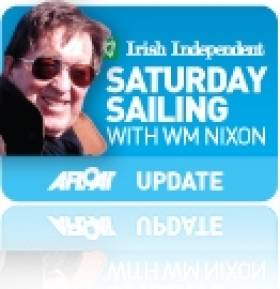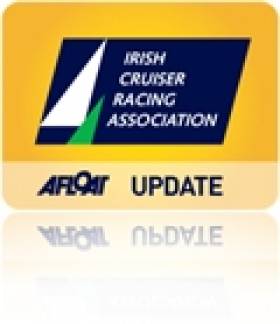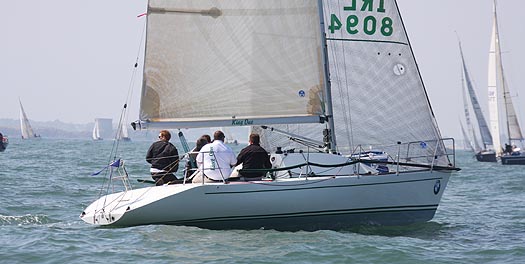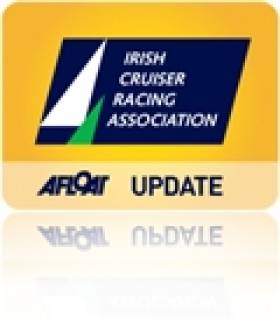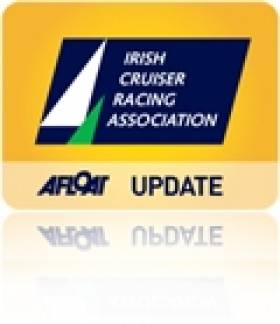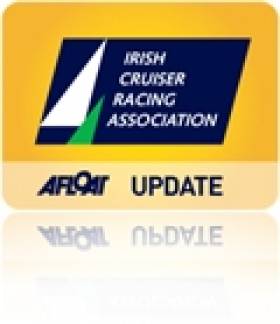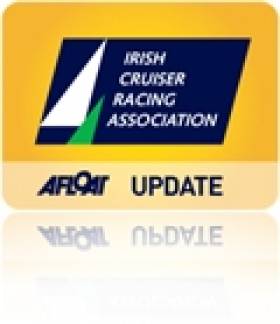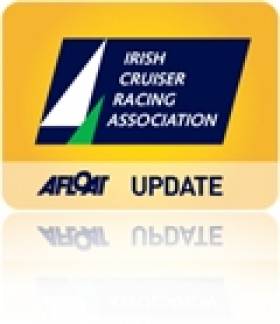Displaying items by tag: ICRA
Shining Thoughts in the Marble City
#icra – The Irish Cruiser Racing Association's (ICRA) annual conference today is in a place better known for its hurling prowess. But over the years Kilkenny has proven a popular venue for the meeting - ICRA has an understandable fondness for the Marble City, for it was here that Fintan Cairns, the late Jim Donegan, and other far-sighted sailing folk brought this most successful organisation into being ten years ago.
At the time, some old stick-in-the-muds (this columnist included) tended to the view that offshore racing organizations should be related to specific sea areas such as the Irish Sea or the North Channel. We were completely and utterly wrong. ICRA took off like a rocket, and has been flying ever since, with the canny Denis Kiely running the back office for the complex number crunching which is essential when you're coordinating racing for boats of many types and sizes.
The annual ICRA Nationals, a crazy new-fangled notion when it was introduced from the beginning as central to the organisation's purpose, has become such a prestigious happening that clubs compete to be selected to stage it. 2012's in Howth in May was a classic, with 115 starters enjoying the last of the Springtime's good weather to have some magnificent racing with a fleet size that other forms of sailing would die for.
Class Zero saw an overall points tie between Anthony O'Leary's Ker 39 Antix and Richard Fildes' Corby 37 Impetuous from South Wales, which the Cork boat won on the countback. Class 1 also went to Cork in the form of the J/109 Jelly Baby (Ian Nagle & Paul O'Malley), Class 2 went to the North Wales/Dublin Bay skipper Nigel Biggs with Checkmate XV, Class 3 went to Cork and George Kenefick's classic Quarter Tonner Tiger, and Class 4 went to Toy Yot from Malahide, an attractive Everitt 22 which had been taken over as a derelict in Malahide Boatyard last winter by a team of marine industry specialists around Malahide Marina headed by Stephen Mullaney. Though the only significant new item to go into the project was a suit of sails from the local Philip Watson loft, the input of much spare time elbow grease resulted in a successful campaign, a lesson for our times.
The ICRA Nationals 2013 will be staged in Tralee with Brian O'Sullivan in charge, and he will be outlining the developing programme at today's gathering. It's a case of shaping the event to suit current economic realities. Even a high flying group like ICRA can feel the effects of the recession as keenly as everyone else, and one of the disappointments of 2012 was having to acknowledge that the resources simply weren't available to mount a defence of the biennial international Commodore's Cup, which the Ireland Team organised by ICRA had won in convincing style in 2010. ICRA Commodore Barry Rose of Cork, who had been the pace-setting manager of the 2010 campaign, explored every possible option to put a campaign in place for 2012, but he made the right call when he declared it a non-runner, concentrating resources instead on serving the sport at home.
One particularly encouraging feature of the past season has been the emergence of strong University crews on the offshore scene. Back in June in the Round Ireland Race, Galway University were right in the hunt with their chartered Reflex 38, and they won their class and placed sixth overall in an international fleet. Buoyed by this success, they head into 2013 with an even more ambitious programme which will include the Fastnet.
At the end of October, the Student Yachting Worlds in France - a classic inshore-offshore event - saw a runaway overall win for Ireland, represented by UCD with Cathal Leigh-Doyle as Captain and Aidan McLaverty as skipper, a result which provides the bonus of Ireland being allocated two team places in the 2013 Worlds.
The UCD campaign was such a good model of its kind that the team will be giving a presentation at today's Kilkenny conference to outline the basics of their approach. And Ireland's own international offshore sailing superstar, Damian Foxall, will also be giving a presentation about being the First Mate aboard Franck Cammas' Groupama, overall winner of the Volvo World Race which concluded in style in Galway.
Barry Rose will be standing down as Commodore with the organisation in good heart, and ICRA being run in a style reminscent of the Government of China, we know already that he will be succeeded by Nobby Reilly of Howth, whose enthusiasm for campaigning his Mills 37 Crazy Horse wth co-owner Alan Chambers at locations on all coasts provides the leadership by example on which sailing organisations thrive.
And then the business will be concluded with the final stages of the voting for the ICRA Boat of the Year. We've a feeling here that it will be Jelly Baby (Ian Nagle and Paul O'Malley). This J/109 is already 2012's Boat of the Year at the Royal Cork, and even with the competition made nationwide, she still fits perfectly into the slot of top boat for these straitened times.
JOHN TWOMEY IS THE MAN FOR THE JOB
We learned last weekend that Irish politics is only in its infancy compared to the workings of the International Sailing Federation as manifested at its annual conference in Dun Laoghaire from November 1st to 11th.
Having 700 delegates certainly creates a steamy brew of intrigue. The big issue was whether it was to be kite-surfing or wind-surfing, or some mixture of both, for inclusion in the 2016 Olympics. Kite-surfing on its own had been voted in to replace windsurfing by the ISAF Council at its meeting in May by a majority of just two votes. But this caused so much grief that the ISAF Events Committee put through a motion last week for a sharing of the Rio de Janeiro slot by both kites and windsurfers.
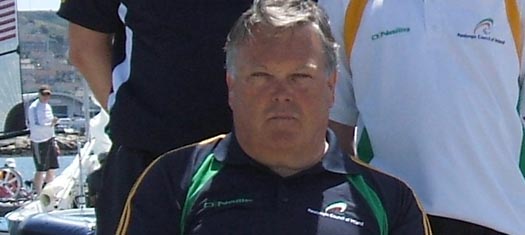
John Twomey brings an unmatched Paralympic participation record to his new role as President of the International Association for Disabled Sailing.
When this reached the Council last Saturday, it wasn't ratified, as they needed a majority of 75% to re-visit a previous decision, and that majority wasn't forthcoming. But the canny wind-surfers still had a secret weapon. The massive AGM with all delegates at the end of the conference can consider all decisions made by the Council, and rejecting them only needs a simple majority.
This particular bazooka was brought into play on Sunday, and the Council's Maytime decision was blown clean out of the water. Windsurfing is back on top. The kiters won't be in the frame at all in Rio. And windsurfers who had "gone over to the other side" by buying kiting equipment since May's decision are now doubly bruised – they've sent money down the drain, and staunch windsurfers regard them as turncoats.
But happily the conference produced a breath of fresh air with the news that John Twomey of Kinsale, Ireland's most dedicated paralympian who has done ten games in both athletics and sailing, has been elected to a four year term as President of the International Association for Disabled Sailing. No better man.
A GREAT MAKING OF SAILING BOOKS
Seems like the launchings of new sailing and maritime books is getting to be like the Number 33 bus. You wait for ever (in the rain of course), and then two come along at once. Last Wednesday provided nautical bibliophiles with an insoluble dilemma. Pete Hogan's lovely new "Log of the Molly B" was being launched south of the Liffey in the Davenport Hotel at 1800 hrs by Conor Brady, former editor of The Irish Times. And north of the river - at precisely the same time in the Customs House - they'd two Government Ministers on hand to launch the hefty new book about the wrecks of Ireland as measured electronically by the new survey ship which is skippered by Sean Cullen.
The Log of the Molly B is proving to be a cult hit, plus it has the virtue of solving Christmas present problems at a stroke, so publishers Liffey Press found themselves in the happy position of running out of copies to sell. Yet people kept waving money at them and they soon had a paid-for list for postage next day.
It was an intriguing evening, with sea-minded alumni of the Cistercian College Roscrea present in strength. CCR is about as far from the sea as you can get in Ireland, but Pete Hogan went there, and so too did Conor Brady, hence the unlikely linkup between the editor of a national newspaper and the reclusive artist-sailor whose talents have proven ideal to producing a beautifully illustrated gem of writing. It seems that though there are Cistercian Monasteries throughout the world, the only one with a school attached is in Roscrea, which might explain how this unique book came to be created.
There's a chance of a replay of the wrecks book launch next Tuesday (November 20th) at 8.0 pm in Poolbeg Y & BC when the Dublin Bay Old Gaffers Association are hosting a talk by Sean Cullen about Captain Bligh, and as a sideline the wrecks book will be on sale.
After the mutiny on the Bounty and Bligh's extraordinary voyage to survival on the ship's boat, the Captain was sent to Dublin for a while to get him out of the limelight, and during his time here he was advising on the development of Dublin Port. So totally did this get Bligh out of the picture for a few years that a recently published biography of him makes no reference to it. But he was here for sure, and he made creative suggestions for the development of Dublin port which continue to benefit the city today.
As for the Dublin Bay Old Gaffers Association, they recently elected the irrepressible Tim Magennis as their President, nicely in time for the Golden Jubilee next year of the OGA. A highlight of the celebrations will be a massive assembly of gaffers and classics in Dublin Bay in June, and Tim will be the ideal man to lead it – he owns the 1894 gaffer Marguerite, designed by Herbert Boyd of Howth and built by Jack Wellington in Malahide, and back in the 1960s he sailed round the world in the Colin Archer ketch Sandefjord skippered by Pat Cullen, whose son Sean is next Tuesday's lecturer.
DUBLIN BAY – CRADLE OF YACHT RACING
Hal Sisk has been at it again. The polymathic yachting historian must have barely paused for breath after masterminding the magisterial book about the Scottish designer G L Watson (published last February) before he got to thinking that the ISAF Conference in Dun Laoghaire would provide the perfect opportunity to remind global sailing's administrators that the basics of modern yacht racing management were laid down on Dublin Bay by the moving spirits in the Royal Alfred Yacht Club, which was founded in 1870.

Don't forget to scald the pot, and use only the best Darjeeling. One of the evocative photos of Dublin Bay sailing by Paget Haffield which are almost a distraction from Hal Sisk's learned discussion of Dun Laoghaire's key role in the creation of modern yacht racing in his new publication, Dublin Bay – The Cradle of Yacht Racing. These two classic sportsmen, complete with Meerschaum pipes, are aboard a becalmed Dublin Bay 25 at the height of the Edwardian era.
The trouble is that over the years, Hal has accumulated so much in the way of historical material that, even more than the rest of us, he needs an editor-in-chief to oversee his every creative move, otherwise we get swamped in the outpouring of information.
But the fact is, Dublin Bay did do the groundwork, but the newly formed Yacht Racing Association took up the Royal Alfred framework so totally that its origins in Dublin Bay were quickly forgotten everywhere else except in Dublin bay, and even then, only by a few. Then too, the Americans tend to think that the basics of the yacht racing rules were almost entirely formulated by Harold S Vanderbilt, and a quaint little club in Ireland would have little chance of successfully staking its claim in the origination stakes when set against the might of the Vanderbilts.
But the deadline of the imminent arrival of the ISAF express meant that Hal and his team just had to get a 50-page book together in jig time. "Dublin Bay-The Cradle of Yacht Racing" was published by Peggy Bawn Press at the end of October, and it's persuasive in its arguments. But when so much pure gold is there to be mined in historic photos, it's easy to be distracted. Hal has access to the glass plate collection of 300 sailing photos taken around Dublin Bay by one Paget Haffield between 1888 and 1914, and the book is dominated by a selection of them. The publishing team just couldn't resist giving a whole page to this image of two very recognisably Dublin sailing types clowning about with the preparation of tea in a complete and utter flat calm aboard a Dublin Bay 25 at the height of the Edwardian era. Do they look as though they care just who invented modern yacht racing?
Details on the book from peggybawnpress.com
Who Will Win ICRA's Irish Boat of the Year Award?
#icra – Top handicap cruisers from the popular sailing centres of Howth, Rush, Cork, Galway and Dublin Bay are in the running for ICRA's Boat of the Year award on Saturday and competition judges have already stated a 'special performance' will be required to win the top prize.
Saturday's ICRA conference has an ambitious agenda covering many important topics for the 2013 cruiser racer season ahead, not least the national championships in Tralee and the election of a new Commodore but by 4pm the delegates attention will turn to the Boat of the Year award, an ICRA highlight.
From a short-list of an X-34, two J109s, a Corby 33, two modified quarter tonners, a half tonner and a Ker 39 what boat will win? Afloat.ie review the season highs of each of the nominated campaigns (and in no particular order).
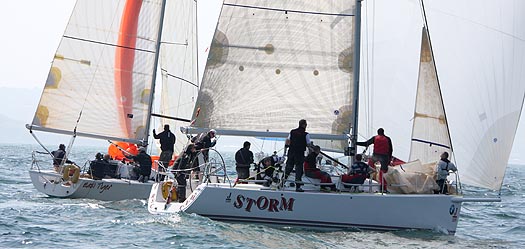
Storm II (J109) Pat Kelly, Rush Sailing Club
Reigning ICRA Boat of the Year Storm II might have lost its ICRA National crown in 2012 but Pat Kelly struck was a very close series on an analysis of the results they lost the entire series by just 10 seconds on the last race. Storm II headed for Scotland following the ICRAs and took their best result on Loch Fyne finishing third on count back.
Back in Dublin Kelly scored his first overall win in 30 years of competing in Howth's Lambay Race. Following this Storm II took honours at the RIYC Regatta in Dublin Bay, bringing the trophy northside. There were also ins in Malahide and Skerries Regattas followed by another win in the September RIYC Regatta. To finish the year off we took five wins and a second in the in Howth Autumn League taking the trophy for the third time in three years and winning overall boat of the series.

Xtravagance (X34) Colin Byrne, Royal Irish Yacht Club
By his own admission the skipper of Xtravagance Colin Byrne says his Dublin Bay based X-34 'didn't have a bad season but equally, we didn't achieve what we wanted to achieve which was to win the ICRAs and to be the top keel boat in Dublin Bay' as they were in 2011. The Royal Irish yacht's results were results included second overall in IRC in the ICRAs and third overall in ECHO.
On Dublin Bay the crew were first overall on Saturdays in DBSC racing in IRC and third overall on Thursdays in IRC. They were second overall on Echo on Saturdays in DBSC. Full DBSC results here for 2012.
The boat also won IRC in the DMYC Regatta and also won the Royal St. George Regatta.
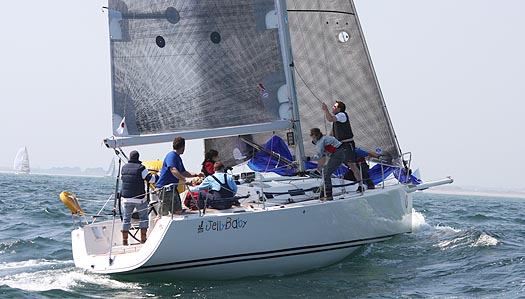
Jelly Baby (J109) Ian Nagle, Royal Cork Yacht Club
The J109 Jelly Baby won a very competitive class at the ICRA Nationals. She also won her class in Cork Week and the J109 Nationals raced as part of the ICRA event and the J109 European title as part Cork Week. Although there were only 4 J 109s in Europeans it was nevertheless a dogfight and only won on the last race on the last day, one of the reasons the Ian Nagle and Paul O'Malley skippered boat has been awarded Royal Cork's own boat of the year trophy.
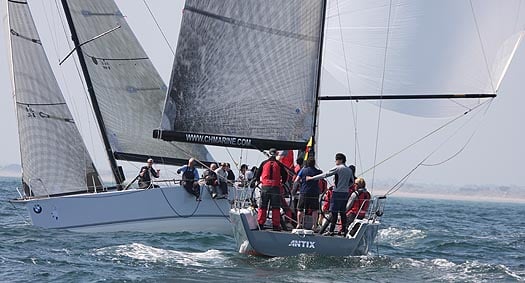
Antix (Ker 39) Anthony O'Leary, Royal Cork Yacht Club
The Captain of ICRA's victorious Commodore's up team in 2010 won the 2012 Easter Series on the Solent. The Ker 39 won Class 0 in the ICRA Nationals in Howth and was successful again on the Solent coming second in the RORC UK IRC Champs. The Anthony O'Leary skippered boat from Royal Cork was also fourth in class at July's Cork Week.

Tiger (Quarter Tonner) Neil Kenefick, Royal Cork Yacht Club
The Kenefick family quarter tonner won her class at the ICRA Nationals in Howth and abroad retained the Corinthian section at the Quarter Ton Worlds on the Solent. This Royal Cork Yacht set out to defend her title and did so in style with her young crew led by George Kenefick (ably assisted by Mike Budd), leading the fleet with five first places and a black flag.
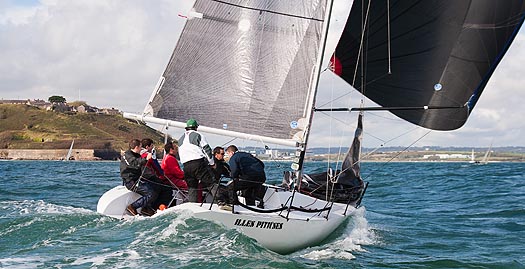
Illes Pitiuses (Quarter Tonner) Losty Bros, Cove Sailing Club
Illes Pitiuses is a modified Quarter Tonner brought back from the Mediterranean by Jason and Dominic Losty last year. The Fauroux design was renovated in Cowes in the Spring of this year. She was second Corinthian Boat behind Tiger at the Quarter Ton Cup in Cowes in it's first major outing, coming 11th overall.
The Cove boat Won Class II at Calves Week and the overall trophy for the Week. She Won Class III and the Moonduster (all-in IRC) Trophy at the Cobh-Blackrock SCORA Race in Cork Harbour.
Illes Pitiuses topped Class II and won the Qaurter Ton Class at the RCYC Autumn Regatta and placed third in the SCORA League despite completing only half the season in Ireland.
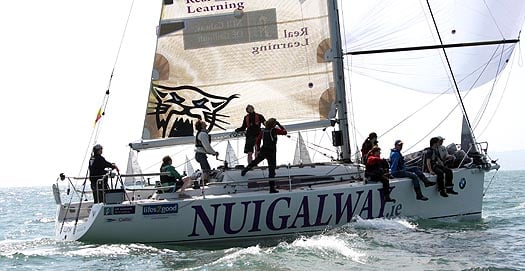
NUI Galway (Reflex 38) Martin Breen, Galway Bay Sailing Club
Following an overall win in the 2011 Dun Laoghaire to Dingle Race as 'Galway Harbour' Martin Breen's Relfex 38 was prepared for the 2012 Round Ireland by students of NUIG and raced as 'NUIGALWAY'. The students won Class 2 and were the first Irish fixed keel boat, finishing sixth overall and winners of the ICRA Cup.
They were also class 1 winners in the Pwllheli to Wicklow ISORA race in preparation for June's Round Ireland race.
The boat is raced by a separate inshore crew and in 2012 they competed in the 2012 ICRA Nationals in Howth, Cork Week and Calves Week. In 2013 they will plan to race at the ICRA Nationals in Fenit and also in the Sovereigns Cup in Kinsale.
Offshore the next events planned for this well sailed Relfex 38 are the 2013 Dun Laoghaire to Dingle race, a RORC Channel race followed by the 2013 Fastnet race.
King One (Half Tonner) Dave Cullen, Howth Yacht Club
Dave Cullen's King One did some travelling around this year summarised as follows: the RORC Easter Regatta in Cowes coming third in a Class of 4B in April. At the ICRAs of home waters King One came third in a fleet of 29 boats. It was followed up at the Howth YC regatta next with a third.
Cullen Headed back to UK to compete against the top Belgian half tonners and competed as part of Class 3 at Ramsgate week. They won the initial coastal series, then the Sail East series, the Half Ton Cup and then followed this up with a win in the overall event as the best scoring boat.
King One returned to Ireland for the HYC Autumn League finishing second.
Next year King One is heading overseas on a French campaign.
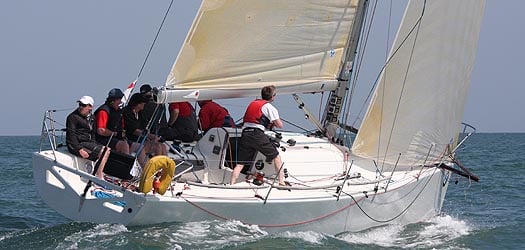
Rockabill (Corby 33) Paul O'Higgins, Royal Irish Yacht Club
Rockabill V boat boss John Kelly has expressed some surprise at his own boat's nomination adding that the Royal Irish YC entry had an 'uneventful season'. The Corby 33 was second in Howth's Corby Cup, third in IRC one at the ICRA nationals, second at the National Yacht club regatta, second to Gloves Off in Calves Week and second in the RIYC end of season regatta.
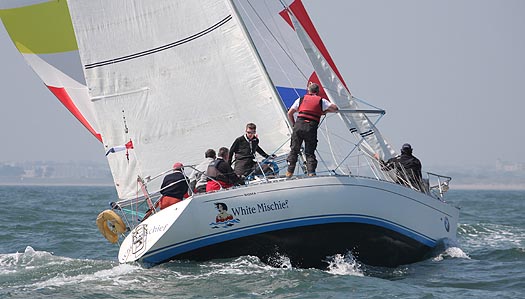
White Mischief (Sigma 33) Tim Goodbody, Royal Irish Yacht Club
Taking time out from her one design performance as the boat to beat in the Sigma 33 class on Dublin Bay, Tim Goodbody's White Mischief came to the ICRA Championships in Howth as a Class 3 and won the Echo division and finished second on IRC. The boat resumed its usual one design position winning her class at the Irish Nationals. In Wales the Royal Irish Yacht took eight wins from eight races at Abersoch Week. On home waters White Mischief took overall wins in the DBSC Thursdays and Saturdays series too.
Kilkenny Conference to Elect New ICRA Commodore
ICRA has issued its final agenda for Saturday's packed conference in Kilkenny with confirmation that there will be 12 different presentations on the day including UCD's account of its world championship win in La Rochelle last month, Damian Foxall on Volvo Ocean Race developments, Race Officer Jack Roy's insight on race management at the Olympic Games, ICRA's boat of the year and the electino of a new ICRA commodore. The conference starts at 10.30am in the Newpark hotel in Kilkenny and is open to all sailors to attend. The full agenda is below and in pdf format for download below too.
AGENDA
ICRA - ANNUAL CONFERENCE 2012, NEWPARK HOTEL KILKENNY
SATURDAY 17TH NOVEMBER – 10.30AM TO 4.30PM
Barry Rose - Commodore
Members of Executive Committee
Barry Rose, Commodore. Norbert Reilly, Vice-Commodore. Fintan Cairns, Treasurer. Denis Kiely, Secretary. Michael Murphy, PR. Ed Alcock, ISA. Peter Beamish. Richard Colwell. Chris Howard. Simon McGibney. Mark Mills. Peadar Murphy. Peter Ryan. Vincent O'Shea. Brian O'Sullivan. Ian Travers.
MORNING SESSION - 10:30-13:00
ANNUAL REPORT – BARRY ROSE, COMMODORE ICRA
Review of 2012 cruiser racing season followed by discussion. 15 mins – to finish by 11:00
FINANCIAL REPORT – FINTAN CAIRNS, TREASURER – 10 mins
APPOINTMENT OF NEW COMMODORE – NORBERT REILLY. – 20 mins
Norbert will make a short presentation on the role of ICRA
Introduce cruiser racing training project
REVIEW OF 2012 NATIONAL CHAMPIONSHIPS HOSTED BY HYC, 25-27 MAY
Richard Colwell to present skipper survey report.
PROGRESS REPORT AND DISCUSSION ON PLANS FOR 2013 NATIONALS TO BE HELD IN TRALEE – 20 mins - Brian o'Sullivan
Notice of Race - issued
Discards and number of races
Mix and Length of courses/races? 1.15 -1.30 typical duration. One long – 3-4 hr – race?
Corinthian Cup and Non-spinnaker racing
Prizes and Prize giving
Feeder Races to ICRA Nats in Tralee? From Dublin, Cork and Galway? perhaps in conjunction with Dun Laoighaire-Dingle
VENUES FOR NEXT CYCLE OF NATIONAL CHAMPIONSHIPS, 2014-2020 – NEW VENUES TO BE CONSIDERED.
Principles - Event is stand-alone and all suitable venues will be considered.
To consider presentations from interested clubs.
RATING AND HANDICAPPING – REPORT FROM IRC CONGRESS 2012
COMMODORES' CUP – THE FUTURE
Full-on Challenge
Progress report on establishment of offshore cruiser racing training program
ALL-IRELAND HELMSMANS CHAMPIONSHIP
Discussion on new nomination system introduced in 2012
JACK ROY [INTERNATIONAL RACE OFFICER] ON THE WEYMOUTH OLYMPICS – 12:30
An opportunity to exchange ideas with a leading Race Officer on developments on cruiser race management, course types etc.
AFTERNOON SESSION – 14:00-16:30
UCD STUDENT CRUISER WORLD CHAMPIONS PRESENTATION
PRESENTATION BY IAN TRAVERS ON PREPARATION & RACING OF ¼ TON TYPE BOATS
'Small boat sailing with a focus on finding, rebuilding and IRC optimising a 'worn out' Quarter Tonner.'
PRESENTATION BY DAMIAN FOXALL, IRELAND'S PREMIER OFFSHORE SAILOR
ICRA BOAT OF THE YEAR PRESENTATION
#icra – Nominees for ICRA's Boat of the Year for 2012 include the reigning champion boat, Pat Kelly's Storm, a J109 from Rush and Howth. Also in the running is Martin Breen's Reflex 38 from Galway Bay Sailing Club sailed this season as 'NUI Galway' but ICRAs Denis Kiely says the ultimate winner of the award to be made at the ICRA conference on November 17 will be the boat that demonstrates an 'extraordinary' year. The 2012 nomination list released by ICRA is below.
There are three Royal Cork boats nominated and two from the Royal Irish Yacht Club.
George Kenefick's modified quarter tonner Tiger is in the running too after its performance in Howth at the ICRA National Championships in May and its Corinthian win of the Quarter ton Cup in the UK
Dave Cullen's modified half tonner King One is also nominated. The Howth yacht captured a huge haul of trophies at Ramsgate week.
'What did each boat do that lifts it out of the pack and places it above all others in 2012 will be a deciding factor says Kiely.
'If there is something special that deserves to be recognised then a headcount of wins in various regattas may not be the determining factor' he adds.
Kiely says there are two stages in the judges decision process. Does the boat have a good season record at national level i.e. performance in a series of top level regattas, and then what is special that makes it worthy of the overall accolade?
Kiely points to the fact that when the original Boat of the year award was made to Voodoo Chile in 2006. 'It was its Round Ireland race win that made it special - a 32 ft boat winning the RI overall. Of course she also had a big programme besides this that but it was the RI win that was special that year' he says.
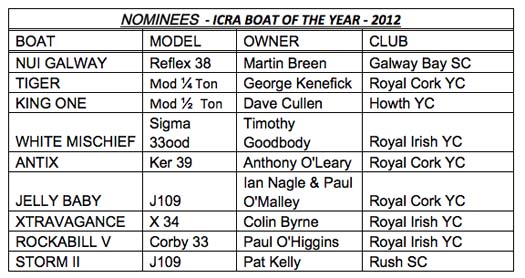
Foxall to Make Round World Presentation at ICRA Conference
#icra – Successful offshore sailor Damian Foxall will make a presentation at this month's ICRA conference in Kilkenny in a fortnight's time entitled: 'Nine Round the World Races Success or Failure?
It will be a further highlight presentation to round off a day that also sees top International Irish Race officer Jack Roy give an account of his experience as a Race Officer at the 2012 Olympics. He will also offer the opportunity to exchange ideas with a leading Race Officer on developments for Cruiser Racing formats.
Kinsale's Ian Travers will also be doing a presentation on small boat sailing and exciting developments in restoring quarter ton yachts for National and International competition.
Ideas for developing a Sail Training Academy by ICRA will also be floated and there will be update on Brewin Dolphin Commodores Cup developments including Irish attempts to field a team to contest the next event in 2014.
Reviews of ICRA Nationals will include a decision on discard format and launch of 2013 event in Fenit.
Venues for future ICRA National Championships will also be discussed. The event is heading for Dun Laoghaire in 2014.
November 17 promises to be an interesting day when all cruiser racing sailors are welcome to attend and have opportunity to exchange ideas on how best Cruiser Racing can develop in the future.
The day will Start at 11am and finish about 4pm in good time for the Rugby match.
ICRA ANNUAL CONFERENCE AGENDA 2012
#icra – The Irish Cruiser Racer (ICRA) conference in Kilkenny will feature a change in format next month when Commodore Barry Rose introduces a round table discussion for the one day event on November 17th at the Newpark hotel. As well as the 2013 National Championship format for Fenit, Co. Kerry ICRA will announce its 2012 Boat of the year.ICRA - ANNUAL CONFERENCE 2012. Full agenda below
ICRA ANNUAL CONFERENCE AGENDA 2012
NEWPARK HOTEL KILKENNY
SATURDAY 17TH NOVEMBER – 10.30AM TO 4.30PM (Agenda A4 v for print out attached below
Barry Rose - Commodore
Members of Executive Committee
Barry Rose, Commodore. Norbert Reilly, Vice-Commodore. Fintan Cairns, Treasurer. Denis Kiely, Secretary. Michael Murphy, PR. Ed Alcock, ISA. Peter Beamish. Richard Colwell. Chris Howard. Simon McGibney. Mark Mills. Peadar Murphy. Peter Ryan. Vincent O'Shea. Brian O'Sullivan. Ian Travers.
AGENDA
MORNING SESSION - 10:30-13:00
• ANNUAL REPORT – BARRY ROSE, COMMODORE ICRA
Review of 2012 cruiser racing season followed by discussion.
• FINANCIAL REPORT – FINTAN CAIRNS, TREASURER
• APPOINTMENT OF NEW COMMODORE – NORBERT REILLY.
o Norbert will make a short presentation on the role of ICRA
• REVIEW OF 2012 NATIONAL CHAMPIONSHIPS HOSTED BY HYC, 25-27 MAY
o Richard Colwell to present skipper survey report.
• PROGRESS REPORT AND DISCUSSION ON PLANS FOR 2013 NATIONALS TO BE HELD IN TRALEE
o Notice of Race
o Discards and number of races
o Mix and Length of courses/races? 1.15 -1.30 typical duration. One long – 3-4 hr – race?
o Corinthian Cup and Non-spinnaker racing
o Prizes and Prize giving
o Other
• VENUES FOR NEXT CYCLE OF NATIONAL CHAMPIONSHIPS, 2014-2020 – NEW VENUES TO BE CONSIDERED. Principles - Event is stand-alone and all suitable venues will be considered. To consider presentations from interested clubs.
• RATING AND HANDICAPPING – REPORT FROM IRC CONGRESS 2012
• COMMODORES' CUP – THE FUTURE
o Progress report on establishment of offshore cruiser racing training program
• ALL-IRELAND HELMSMANS CHAMPIONSHIP
o Discussion on new nomination system introduced in 2012
• DISCUSSION ON DEVELOPMENTS ON OFFSHORE RACING
o Feeder Races to ICRA Nats in Tralee? From Dublin, Cork and Galway? perhaps in conjunction with Dun Laoighaire-Dingle
AFTERNOON SESSION – 14:00-16:30
JACK ROY [INTERNATIONAL RACE OFFICER] ON THE WEYMOUTH OLYMPICS
An opportunity to exchange ideas with a leading Race Officer on developments on cruiser race management, course types etc.
PRESENTATION BY IAN TRAVERS ON PREPARATION & RACING OF ¼ TON TYPE BOATS
'Small boat sailing with a focus on finding, rebuilding and IRC optimising a 'worn out' Quarter Tonner.'
PRESENTATION BY DAMIAN FOXALL, IRISH OFFSHORE SAILOR
ICRA - ANNUAL CONFERENCE 2012
• 'BOAT OF THE YEAR' PRESENTATION
Key Sailors to be Invited to New Format ICRA Conference
#ICRA – Irish Cruiser Racing Associaton (ICRA) chief Barry Rose is to personally invite key individual sailors to participate in a new format for November's annual conference in Kilkenny.
The aim is to to encourage much greater participation by all present. Instead of a top table facing ranks of chairs/attendees ICRA are going for a 'round table' layout and are expecting to boost its regular 50 member turnout.
The line up for the event includes Olympic race officer Jack Roy and some other speakers yet to be announced.
'The people we want on this list come under a number of headings; regular competitors in the national championships, regular attendees at previous conferences, people who have set up new/interesting initiatives in cruiser sailing and perhaps most importantly, people who have something to say,' says the association's Denis Kiely.
Rose wants to get a spread of sailors from all parts of the country to participate. The conference is at the Newpark hotel in Kilkenny on November 17, 2012.
Kilkenny ICRA Conference to Feature Olympic, Quarter Ton & Discard Discussion
#icra – November's Irish Cruiser Racer Conference (ICRA) in Kilkenny on November 17th will feature reports from the Olympic Games from Dun Laoghaire race officer Jack Roy who officiated in Weymouth, ICRA will also propose a new youth sailing academy and Ian Travers will report on the rise and rise of the Quarter ton fleet.
The packed one day conference is an opportunity for all cruiser racing sailors to exchange views and engage on all issues that are important to sector. All cruiser sailors are automatically members of ICRA and are very welcome.
The conference will also see the presentation of ICRA's boat of the year award. Nominations are invited.
A discussion on the issue of discards at the 2013 ICRA National Championships at Tralee Bay Sailing Club at Fenit will also take place.
Options for the biggest cruiser event of the year include one discard after six races are sailed or the last race is non discardable as has been the case for last two years or that championships becomes a non discard event.
The Kilkenny conference at the Newpark hotel will review the 2012 Nationals at Howth and it will include a presentation of a professional survey carried out by Richard Colwell.
ICRA will propose ideas for development of a Sailing Academy to encourage participation of young sailors in major International events.
Ian Travers will make an interesting and informative presentation on developments in small boat sailing including recent progress of the quarter ton class and his experience of restoring a leading edge quarter tonner.
Jack Roy recently returned from Race officer duties at Olympics will share his experience and offer the opportunity to engage with a leading Race Officer on issues of relevance to racing sailors.
There will be an update of developments on Brewin Dolphin Commodores Cup and Ireland's efforts to field a team for the next event in 2014.
There will be an update on the new system of nomination for places at ISA all Ireland sailing Championships and how it impacts on ICRA National Championship Winners.
ICRA also hope to announce a further speaker shortly.
The ICRA conference is always a good day out where all those attending are encouraged to engage and air their views over the day.
ICRA Seek Feedback on Future Commodore's Cup Regattas
#icra – A root and branch review of the Commodore's Cup competition will examine all aspects of the the regatta including future boat types, team formats, event format, and professional sailor participation.
Organisers, the Royal Ocean Racing Club (RORC), have offered Irish sailors the opportunity to submit feedback through the Irish Cruiser Racing Association (ICRA).
Ireland won the 2010 event but did not defend the biennial title last August when they could not muster a three boat team.
RORC are keen on getting maximum participation for future events. Ireland won the 2010 event but did not defend the title last August.
'RORC are taking the view of starting with a clean sheet and are open to ideas as to how best to maintain and grow the attraction' says ICRA Commodore Barry Rose.
There is time pressure as the next RORC meeting to discuss these issues takes place in two weeks so ICRA are seeking feedback in the next 10 days.
Responses to [email protected]
Ireland Pulls Out of Commodore's Cup
Ireland will not defend the Commodore's Cup title it won in 2010 it has been announced this afternoon after weeks of doubt about Ireland's ability to put a competitive three boat team together.
There will be little surprise with the Irish Cruiser Racing Association confirmation that despite exhaustive efforts over a long period it has not been possible in the current environment to mount a defence team for the upcoming Brewin Dolphin Commodores Cup.
ICRA Commodore Barry Rose thanked all those who worked hard in striving to achieve a team especially 2010 winning team Captain Anthony O'Leary and looks forward with confidence to returning with a credible team for the 2014 event.
The ICRA announcement continued: "ICRA wishes the RORC and Brewin Dolphin Commodores Cup organisation every success with the event. The event is held in the highest regard in Ireland and the Irish team were thrilled to win it for the first time in 2010. We look forward to being back strongly in 2014".




























